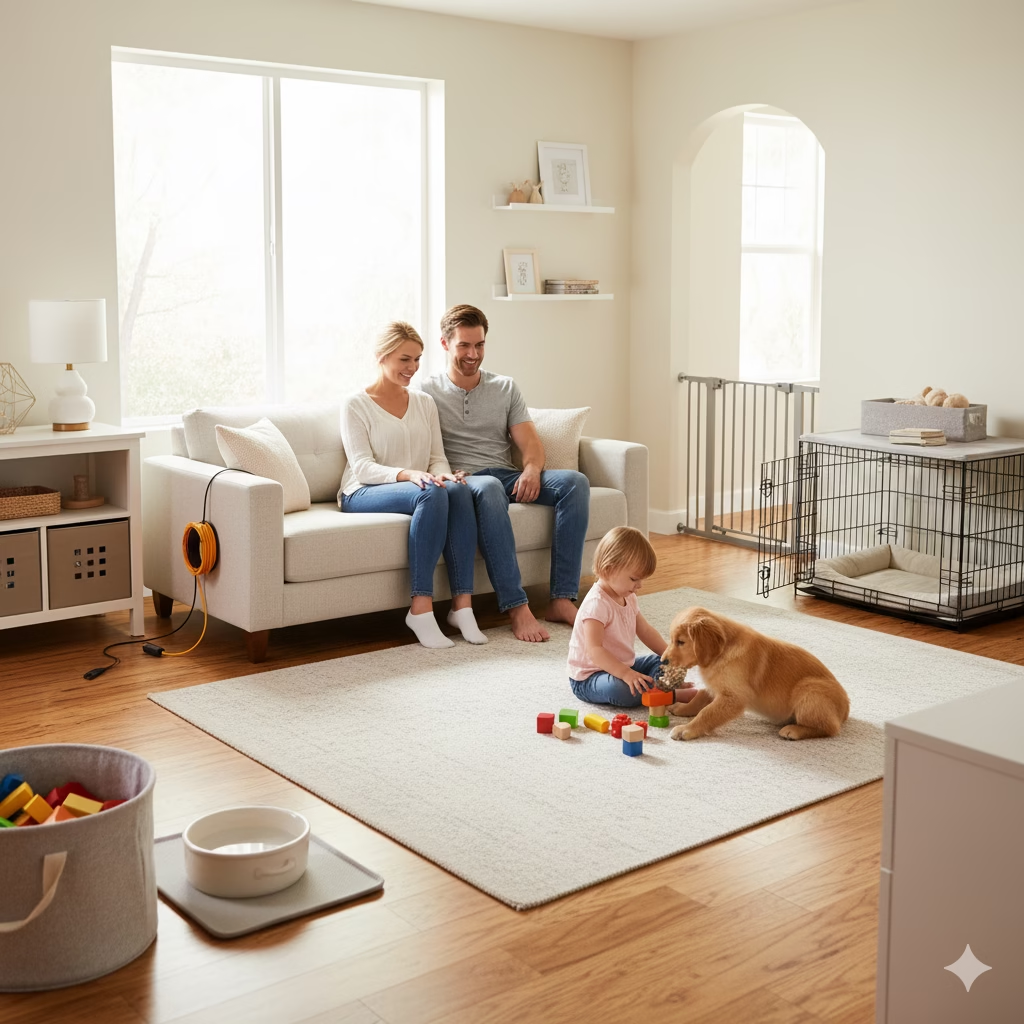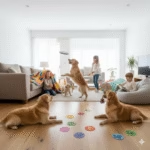The Beautiful, Unspoken Chaos of a “Dual-Species” Household
I have a distinct memory from when our Golden, Sunny, was about four months old. I walked into our living room to find a scene of beautiful, unspoken chaos. My three-year-old son had meticulously unpacked a basket of clean laundry, creating a “mountain” on the floor. At the peak of this mountain, Sunny was triumphantly disemboweling a decorative throw pillow, sending fluff drifting through the air like gentle snow. Neither of them was doing anything malicious. They were both just exploring their world in the best way they knew how.
In that moment, I realized a profound truth: my job wasn’t to stop a curious puppy from being a puppy or a curious child from being a child. My job was to create an environment where their natural curiosities could coexist safely and without destroying our home (or my sanity).
This is the art of “double-proofing.” We all hear about kid-proofing our homes—covering outlets, locking cabinets. And new owners hear about puppy-proofing—hiding shoes, securing trash. But when you bring a puppy into a home with young kids, you enter a new dimension. You have two small, unpredictable beings operating at the same low altitude, both masters of putting things in their mouths. Preparing your home isn’t just a chore; it’s the single most effective strategy for reducing stress, preventing emergencies, and fostering a peaceful coexistence from day one. Let’s tour the house.
The Guiding Philosophy: Manage the Environment, Not the Impulse
Before we dive into the room-by-room specifics, let’s embrace the core philosophy. You will exhaust yourself if your primary strategy is to shout “No!” all day long. A curious puppy will chew, and a curious toddler will explore. Constantly correcting these natural impulses creates a negative, stressful environment. The far more effective and peaceful approach is to manage their environment so that the opportunity for a “bad” choice rarely presents itself. A safe home is a calm home.
Puppy-Proofing 101: A Tour from a Puppy’s-Eye View
To truly puppy-proof, you have to get on your hands and knees. Literally. See the world from their vantage point. What is dangling? What is accessible? What looks deliciously chewable?
H3: The Living Room: The Heart of the Home and Hazard Central
This is where your family and your puppy will spend the most time, so it needs the most attention.
- Electrical Cords and Wires: To a teething puppy, a dangling power cord looks like a fantastic chew toy. This is arguably the most immediate danger. My solution was a multi-pronged attack. We used hard plastic cord concealers that run along the baseboards to hide TV and lamp cords. For stray phone chargers, we got into the militant habit of unplugging them and putting them away immediately after use. For the unavoidable few, a thin layer of bitter apple spray can act as a deterrent, but physical barriers are always better.
- Furniture: Those lovely wooden legs on your coffee table or chairs are the perfect texture for a teething puppy. Before Sunny arrived, I bought a few long-lasting, safe chew toys (like a rubber Kong and a nylon Nylabone). The key is to make these more appealing than the furniture. If I ever saw him heading for a chair leg, I wouldn’t scold him; I’d excitedly say “Here’s YOUR toy!” and redirect him to the appropriate item.
- Toxic Houseplants: Many common houseplants are toxic to dogs. I did a full audit of our home. Common culprits like lilies, Sago Palms, and Dieffenbachia had to go. Others, like our Fiddle Leaf Fig, were moved to rooms that would be gated off. If you’re unsure about a plant, the ASPCA has an exhaustive, searchable database online. It’s not worth the risk.
- The Low-Hanging Fruit: Remote controls, shoes, kids’ toys, books, and magazines left on coffee tables are puppy magnets. This is where new habits are non-negotiable. We invested in a few stylish woven baskets with lids. One was for remotes, one was for shoes by the door. It became a family rule: if it’s not in its basket, it’s fair game for the puppy.
H3: The Kitchen: A Buffet of Temptations and Dangers
The kitchen is a sensory wonderland for a Golden. Wonderful smells, dropped food, and fascinating cupboards make it irresistible.
- The Trash Can: A Golden’s nose is a superpower, and your trash can is the ultimate treasure chest. A simple step-can is no match for a determined dog. We invested in a heavy, stainless-steel can with a secure locking lid. This is a non-negotiable piece of equipment. I’ve heard too many horror stories of dogs ingesting cooked chicken bones or coffee grounds.
- Cabinets and Pantries: Any cabinet within reach that contains food or, more importantly, cleaning chemicals, must be secured. We installed magnetic child-proof locks on all lower cabinets. This protected the puppy from dangerous chemicals and my pantry from being raided.
- Counter Surfing and Dangerous Foods: Goldens are tall enough to become expert counter surfers. This is dangerous because of the many human foods that are toxic to them: grapes, raisins, onions, garlic, chocolate, and anything containing the artificial sweetener xylitol (found in many peanut butters and baked goods). We became militant about keeping counters clear and pushing everything to the very back. We also taught a rock-solid “Leave It” command from day one.
Kid-Proofing for Your Puppy: Protecting Them from Accidental Harm
This is the side of the equation that people often forget. You also need to protect your new puppy from the well-intentioned but potentially harmful actions of your children.
H3: The Great Toy Divide: His, Hers, and Never the Twain Shall Meet
To a puppy, there is no difference between their squeaky plush hedgehog and your child’s favorite stuffed unicorn. To a toddler, a fun-looking rope tug toy is just another thing to play with. This confusion is a recipe for disaster. Small parts from a child’s toy (like the eye of a teddy bear or a LEGO brick) can be easily swallowed by a puppy, leading to a life-threatening intestinal blockage.
Our solution was a strict policy of toy segregation.
- The kids’ toys lived in their rooms or in designated toy boxes in the playroom. The rule was that playtime happened in these rooms, and toys were put away immediately afterward.
- Sunny’s toys lived in a specific basket in the living room.
- The most important rule: We never, ever take a toy from the puppy’s mouth. If Sunny mistakenly picked up a child’s toy, the kids’ job was to immediately come and tell an adult. I would then perform a “trade up” by offering him a super high-value treat in exchange for the toy. This prevents resource guarding and keeps everyone safe.
H3: The Importance of “Dog-Free” and “Kid-Free” Zones
Every member of the family deserves a space where they can relax without being bothered. Using baby gates, we created a flexible system of zones.
- The Puppy’s Safe Zone: When Sunny was napping in his crate/pen, the kids knew he was off-limits. This ensured he got the rest he needed and prevented him from getting cranky.
- The Kids’ Safe Zone: The playroom was often gated off. This allowed my son to build his elaborate LEGO castles on the floor without me having to worry about a clumsy puppy trampling it or swallowing a piece. It gave them both a break from each other.
H3: The Feeding Station Sanctuary
A dog’s food bowl is their personal property. A child hovering over a dog while it’s eating can trigger a defensive, resource-guarding instinct in even the sweetest Golden. We placed Sunny’s food and water bowls in a quiet, low-traffic corner of the kitchen. The rule was simple: when Sunny is eating, we leave him completely alone.
The Management Trifecta: Your Three Most Valuable Tools
All of this proofing is supported by three essential management tools.
- The Crate: This is not a jail. It is your puppy’s den, their bedroom. It’s the ultimate tool for keeping them safe when you can’t supervise them (like when you’re sleeping, showering, or running a quick errand).
- Baby Gates: I call these “sanity savers.” Use them liberally to block off rooms, protect safe zones, and manage the environment without constant verbal commands.
- The Indoor Leash: For the first few weeks, whenever Sunny was out of his crate and not in a gated area, he was often on a lightweight leash held by me. This “umbilical cord” method prevented him from wandering off to chew on a cord or have a potty accident before I could notice the signs.
Conclusion: A Temporary Investment for Permanent Peace
Reading this might feel overwhelming. It might seem like you’re turning your home into a fortress. But please, hear me on this: this intense management phase is temporary. It’s a short-term, upfront investment that pays a lifetime of dividends in safety and peace. As your puppy matures and learns the rules, and as your child grows and understands the boundaries, you can slowly relax the fortifications. The locks come off, the gates come down.
You do it all so that you can get to the good stuff—the quiet cuddles on the couch, the games of fetch in the yard, the unwavering friendship—without the background noise of stress and worry. You are building a safe harbor where that beautiful relationship can set sail.
A Real-Life Tip: For lower cabinets and even our fridge, my favorite cheap and effective lock wasn’t a fancy baby-proofing gadget. It was a simple, rock-climber’s carabiner clip. I would clip it through the handles of two adjoining cabinets or the double handles of our French-door fridge. It’s too complex for a toddler to operate quickly and strong enough to deter a curious puppy. It costs a couple of dollars and provides total peace of mind.

Rafael Souza is a digital marketing strategist and lifelong dog enthusiast. Passionate about Golden Retrievers, he shares practical, research-based tips to help owners provide healthier and happier lives for their furry companions.





